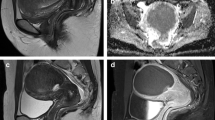Abstract
Objective: To investigate the association between magnetic resonance imaging (MRI) classification and symptom relief after uterine artery embolization (UAE) in patients with adenomyosis. Methods: Totally, 73 patients with symptomatic adenomyosis who underwent UAE were retrospectively analyzed. Preoperative MRI classification was defined as: type I, high signal on both T2-weighted images (T2WI) and T1-weighted images (T1WI); type III, high signal only on T2WI, and type II, high signal on neither T1WI nor T2WI. Dysmenorrhea was measured with the visual-analog scales and the degree of menorrhagia was measured according to the number of sanitary pads used in one menstrual cycle. Dysmenorrhea and menorrhagia were measured before UAE and 12 months after UAE. Results: The number of the type I, II, III cases was 23, 37, and 13, respectively. The baseline characteristics of the three groups exhibited no significant difference. The alleviation rates of dysmenorrhea among type I, II, III cases were 73.9%, 89.2%, and 84.6%, respectively (P=0.455). The alleviation rates of menorrhagia for type I, II, III were 69.6%, 78.4%, and 92.3%, respectively (P=0.714). Conclusion: Pre-procedure MRI classification and symptom relief after UAE exhibited no significant association. UAE has a favorable mid-term control on dysmenorrhea and menorrhagia among patients with adenomyosis. Preoperative MRI classification might not indicate symptom relief. More research is needed before changing clinical practice.
Similar content being viewed by others
References
Cunningham RK, Horrow MM, Smith RJ, et al. Adenomyosis: A Sonographic Diagnosis. Radiographics, 2018,38(5):1576–1589
Struble J, Reid S, Bedaiwy MA. Adenomyosis: A Clinical Review of a Challenging Gynecologic Condition. J Minim Invasive Gynecol, 2016,23(2):164–185.
Farquhar C, Brosens I. Medical and surgical management of adenomyosis. Best Pract Res Clin Obstet Gynaecol, 2006,20(4):603–616
Volkers NA, Hehenkamp WJ, Smit P, et al. Economic evaluation of uterine artery embolization versus hysterectomy in the treatment of symptomatic uterine fibroids: results from the randomized EMMY trial. J Vasc Interv Radiol, 2008,19(7):1007–1016
Dessouky R, Gamil SA, Nada MG, et al. Management of uterine adenomyosis: current trends and uterine artery embolization as a potential alternative to hysterectomy. Insights Imaging, 2019,10(1):48
Keung JJ, Spies JB, Caridi TM. Uterine artery embolization: A review of current concepts. Best Pract Res Clin Obstet Gynaecol, 2018,46:66–73
Popovic M, Puchner S, Berzaczy D, et al. Uterine artery embolization for the treatment of adenomyosis: a review. J Vasc Interv Radiol, 2011,22(7):901–909
de Bruijn AM, Smink M, Lohle PNM, et al. Uterine Artery Embolization for the Treatment of Adenomyosis: A Systematic Review and Meta-Analysis. J Vasc Interv Radiol, 2017,28(12):1629–1642
Dueholm M, Lundorf E, Hansen ES, et al. Magnetic resonance imaging and transvaginal ultrasonography for the diagnosis of adenomyosis. Fertil Steril, 2001,76(3): 588–594
Bazot M, Cortez A, Darai E, et al. Ultrasonography compared with magnetic resonance imaging for the diagnosis of adenomyosis: correlation with histopathology. Hum Reprod, 2001,16(11):2427–2433
Kim MD, Kim YM, Kim HC, et al. Uterine artery embolization for symptomatic adenomyosis: a new technical development of the 1-2-3 protocol and predictive factors of MR imaging affecting outcomes. J Vasc Interv Radiol, 2011,22(4):497–502
Jung DC, Kim MD, Oh YT, et al. Prediction of early response to uterine arterial embolisation of adenomyosis: value of T2 signal intensity ratio of adenomyosis. Eur Radiol, 2012,22(9):2044–2049
Tamai K, Togashi K, Ito T, et al. MR imaging findings of adenomyosis: correlation with histopathologic features and diagnostic pitfalls. Radiographics, 2005,25(1):21–40
Rabinovici J, Stewart EA. New interventional techniques for adenomyosis. Best Pract Res Clin Obstet Gynaecol, 2006,20(4):617–636
Institute of Medicine (US) Committee on Pain, Disability, and Chronic Illness Behavior. Pain and Disability: Clinical, Behavioral, and Public Policy Perspectives. Osterweis M, Kleinman A, Mechanic D, editors. Washington (DC): National Academies Press (US), 1987.
Goodwin SC, McLucas B, Lee M, et al. Uterine artery embolization for the treatment of uterine leiomyomata midterm results. J Vasc Interv Radiol, 1999,10(9):1159–1165
Liang E, Brown B, Kirsop R, et al. Efficacy of uterine artery embolisation for treatment of symptomatic fibroids and adenomyosis - an interim report on an Australian experience. Aust N Z J Obstet Gynaecol, 2012,52(2):106–112
Author information
Authors and Affiliations
Corresponding author
Additional information
Conflict of Interest Statement
There are no potential conflicts of interest to disclose.
Rights and permissions
About this article
Cite this article
Guo, Wb., Hu, Sq., Wan, Tt. et al. Preoperative MRI Classification May Not Predict Symptom Relief after Uterine Artery Embolization in Patients with Adenomyosis. CURR MED SCI 41, 1252–1256 (2021). https://doi.org/10.1007/s11596-021-2473-4
Received:
Accepted:
Published:
Issue Date:
DOI: https://doi.org/10.1007/s11596-021-2473-4




